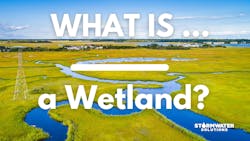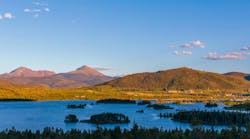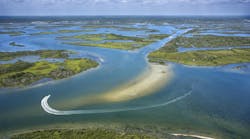What is a wetland?
Wetlands are areas where water covers the soil, or is present either at or near the surface of the soil all year or for varying period of time during the year, including during growing season. [1]
According to the U.S. Environmental Protection Agency (EPA), water saturation largely determines how soil develops and the types of plant and animal communities living in and on the soil. Wetlands may support both aquatic and terrestrial species.
The water that settles in wetlands can create conditions that are favorable for the growth of specially adapted plants and promotes the development of characteristic wetland soils.
What are the categories of wetlands?
Wetlands can vary widely due to different locations and climates. A wetland near a beach will be different than a wetland set inland.
Two general categories of wetland are recognized: coastal or tidal wetlands and inland or non-tidal wetlands.[2]
Coastal/tidal wetlands
Coastal/tidal wetlands in the U.S. can be found along the Atlantic, Pacific, Alaskan and Gulf coasts.
These wetlands are closely linked to the nation’s estuaries where sea water mixes with fresh water to form an environment of varying salinities.
The saltwater and the fluctuating water levels, due to tidal action, combine to create a difficult environment for most plants. This means that most shallow coastal wetlands are usually unvegetated mud flats or sand flats.
Some plants have successfully adapted to this environment, however. Certain grasses and grasslike plants that adapt to the saline conditions can be found in these areas.
Some salt-loving shrubs or trees are common in tropical climates, such as in southern Florida and Puerto Rico.
Some tidal freshwater wetlands form around the upper edges of tidal salt marshes where the influence of saltwater ends.
Inland/non-tidal wetlands
Inland/non-tidal wetlands are common on floodplains along rivers and stream, in isolated depressions surrounded by dry land, along the margins of lakes and ponds, and in other low-lying areas where the groundwater intercepts the soil surface or where precipitation sufficiently saturates the soil.
Inland wetlands include marshes and wet meadows dominated by herbaceous plants, swamps dominated by shrubs, and wooded swamps dominated by trees.[3]
What are examples of wetlands?
Wetlands can go by many different names such as swamps, peatlands, sloughs, marshes, muskegs, bogs, fens, potholes and mires.
They’re commonly referred to by scientists as swamps, marshes and bogs—the three major kinds of wetlands.[4]
Swamps
A swamp is a wetland that is permanently saturated with water and dominated by trees.
Swamps can form with either saltwater or freshwater.
Saltwater swamps are usually found around tropical coastlines. Formation of saltwater swamps begin with bare flats of mud or sand that are covered by seawater during high tides. The brackish water of saltwater swamps is not entirely seawater, nor entirely freshwater.
Freshwater swamps can form on flat land around lakes or streams, where the water table is high, and runoff is slow.
Seasonal flooding and rainfall can cause the water level in these swamps to fluctuate or change.
Water-tolerant plants, like cattails, lotus and cypress, grow in the swamp’s wet soil, and they’re key to maintaining the swamp’s ecosystem.
Marshes
Swamps can often give way to marshes. Marshes form a flat, grassy fringe near river mouths, in bays and along coastlines.
They’re often exposed by the movement of tides, and, like swamps, are divided into freshwater and saltwater categories.
Freshwater marshes can be found more inland from the coast and are dominated by grasses and aquatic plants. Freshwater marshes can develop around lakes and streams.
Saltwater marshes often overlap with freshwater marshes of rivers. They are some of the richest ecosystems for biodiversity.
Saltwater marshes are dominated by grasses that provide food and shelter for algae, fungi, shellfish, fish, amphibians and reptiles. Wading birds and other animals feed on the vegetation and insects.
Bogs
Swamps and marshes are wetlands that can commonly be found in warm climates. Bogs differ because they are more common in cold or arctic areas. They also exist at high altitudes in warmer regions.
Bogs develop in areas where the water table is high. Bogs form when glacial depressions, or kettle lakes, gradually fill with plant debris.
Plant debris such as leaves, roots and stems of larger plants accumulate on the bottom of the lake beds. As the lake becomes shallower, mosses and plants grow along the edges of the lake. They form a floating layer of tangled vegetation on the water surface.
These plants are then followed by water-loving grasses. The oldest and partially decayed grasses collect at the bottom of the bog and form a thick mat, called peat.
Where are wetlands found?
As we’ve learned, wetlands can take on many different climates, shapes, sizes and compositions.
Due to wetlands’ abilities to handle different climates, they can be found everywhere, from the tundra to the tropics. Wetlands can be found on every continent except Antarctica.
Why are wetlands disappearing?
A recent report released by the U.S. Fish and Wildlife Service states that wetlands covered less than 6% of the lower 48 states as of 2019. This is half the area they covered since the 1780s.[5]
The report also identifies that loss rates have increased by 50% since 2009, and that losses have disproportionately impacted marshes and swamps.
The main factors of loss have shifted over time. In the mid-1900s, loss was primarily caused by drainage and fill associated with agricultural production.
During the 2009 through 2019 study period, loss was associated with development, upland planted forest and agriculture. Other drivers of loss likely contributed as well, such climate change and sea level rise.
What causes wetlands?
Although wetlands can take thousands of years to develop, some can form quickly due to things like flooding.
Wetlands can form due to flooding of coastal lowlands, from river floodplains, glaciers and other forces of nature.[6]
Flooding from coastal lowlands from rising sea levels has created coastal marshes that are protected from wave action by islands or reefs.
River floodplains develop through erosion processes and through deposition of sediment on adjacent lands during floods.
Glaciers created wetlands in norther states hundreds of centuries ago. Large wetlands formed when glaciers dammed rivers, scoured valleys and reworked floodplains.
Wetlands can also form from wind erosion that create depressions as well as sink holes and other areas where percolating water has dissolved bedrock.
People can also create wetlands purposefully or by accident from highways and dam construction.
Beavers have also been known to create wetlands by damming rivers and streams.
Sources
[1]https://www.epa.gov/wetlands/what-wetland
[2]https://www.epa.gov/wetlands/what-wetland
[3]https://www.epa.gov/wetlands/what-wetland
[4]https://education.nationalgeographic.org/resource/wetland/
[5]https://www.fws.gov/press-release/2024-03/continued-decline-wetlands-documented-new-us-fish-and-wildlife-service-report#:~:text=The%20main%20drivers%20of%20wetland,upland%20planted%20forest%2C%20and%20agriculture.
[6]https://www.nps.gov/subjects/wetlands/how.htm#:~:text=Wetlands%20form%20on%20floodplains%20where,floodplain%20or%20deposit%20new%20material.
About the Author
Alex Cossin
Associate Editor
Alex Cossin is the associate editor for Waterworld Magazine, Wastewater Digest and Stormwater Solutions, which compose the Endeavor Business Media Water Group. Cossin graduated from Kent State University in 2018 with a Bachelor of Science in Journalism. Cossin can be reached at [email protected].




